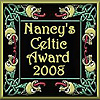| |

Traditions, folklore, history and more. If it's Irish, it's here. Or will be!
"People will not look forward to posterity who never look backward to their ancestors."
-Edmund Burke




Quotes
Library: Books, Movies, Music
Prints & Photos
Poetry
Jokes


Shops Ireland
Bunús na Gaeilge
(Basic Irish)
Circle of Prayer
Blessings
Did You Know?
Himself/Herself
Write to Us
Readers Write..
Links/Link to Us
Advertise with us
Awards & Testimonials
Submissions Guide


|
|
|
Celebrating St. Michael's Day in Old Ireland
by Bridget Haggerty

Throughout the Celtic lands, Michaelmas - September 29, marked the end of the harvest. This was the time that farm folk calculated how many animals they could afford to feed over the winter and how many would have to be sold or slaughtered and salted down in order to preserve the meat.
In addition to livestock fairs, rural folk attended hiring fairs which were especially important for farm laborers looking for winter employment after the harvest.
Michaelmas was also one of the regular quarter-days for settling rents and accounts; often, since this was also the time of the "geese harvest", many a farmer paid off his accounts with a brace or more of plump birds from the flock hatched in the spring. Traditionally, on St. Michael's Day, Irish families sat down to a roast goose dinner.
Michaelmas also marked the end of the fishing season, the beginning of the hunting season, the traditional time to pick apples and the time to make cider. In County Waterford, it was also the end of the tourist season. This gave rise to a strange custom observed by those in the holiday trade - they held a procession to the beach and cast an effigy of St. Michael into the sea as a symbolic protest against loss of earnings.
In many parts of Ireland, farmers gave geese as gifts to the poor and sold the down as fillings for mattresses and pillows. In several towns, Michaelmas was the day to elect a mayor. As the story goes, it was the tradition that the Mayor of Dublin could not be sworn in until after his counterpart in Drogheda. Where this custom came from, no-one seems to know.
According to Kevin Danaher's The Year in Ireland, the feast of St. Michael had no special significance in ancient Ireland. It was the coming of the Anglo-Normans and the establishment of their legal customs that gave Michelmas an important place in the Irish calendar.
In doing further research on the Irish celebration of Michaelmas, we found references to Michaelmas Pie. In the old days, it was the custom to hide a ring in the pie and the person who found it would be married within the year. Intrigued by the custom, we went looking for a recipe. Extensive searches turned up nothing; however, since the traditional main course on this date would be roast goose, logic dictates that the pie was probably sweet, not savory. There's another old bit of folklore that leads us to think it might have been a pie made with blackberries as part of the filling. It was once believed that on the feast of St. Michael, the devil spat on the blackberries (or worse!) and it was therefore very unwise to pick and eat the fruit after September 29th. According to the old tale, when St. Michael cast Satan from Heaven, the devil landed on earth in a patch of brambles and he returns every year to spit on the plant that tortured him, breathing his foul breath over it and trampling it.
Not wanting anything to go to waste, especially free food, believers in this tale would have gathered as many blackberries as they could. They would then use them in pies, crumbles and jams. Apples were also plentiful at this time of year, so it is quite likely that they would also be used in the pie. (See recipe for Michaelmas Pie in the Irish Kitchen).
As for the main course - roast goose - how this came to be the traditional meal most likely comes from English settlers. During the Middle Ages, St. Michael's Day was a great religious feast in most of western Europe, coinciding as it did with the end of the harvest. In England it was the custom to eat a goose on Michaelmas, which was supposed to protect against financial need for the next year. "He who eats goose on Michaelmas day shan't money lack or debts to pay". (See recipe for Michaelmas Goose in the Irish Kitchen)
Spring-hatched geese are ready for market beginning on Michaelmas and this goose harvest is known as Fomhar na ngean. The goose was supposed to be eaten up the by September 30th and the breastbone was used to foretell the weather for the coming winter by holding it up to the light. A translucent breastbone meant that the coming winter would be mild, while a thick breastbone meant it would be a hard winter. A mottled breastbone meant the coming winter would be variable. The front part of the breastbone applied to the early winter while the back half told of the weather for the period after Christmas.
Traditionally, celebration of this holiday was symbolized with "glofe, gees, and gyngeuer." The glove represented the open-handedness and generosity of the lord of the village, eating goose gave good luck in the coming year, and ginger was believed to provide protection against infection.
Since geese were so plentiful and were now ready to be harvested, it's easy to understand why a goose became the traditional main course. However, there is a fascinating story that has become part of British folklore. Supposedly, Queen Elizabeth I dined at the ancient seat of Sir Neville Umfreyville, where, among other things, two fine geese were provided for dinner. The queen, having eaten heartily, called for a bumper of Burgundy; and gave as a toast, "Destruction to the Spanish Armada!" Scarcely had she spoken when a messenger announced the destruction of the fleet by a storm. The queen demanded a second bumper, and said, "Henceforth shall a goose commemorate this great victory." This tale is marred by the awkward circumstance that the thanksgiving sermon for the victory was preached at St. Paul's on the 20th August, and the fleet was dispersed by the winds in July.
There are other customs and traditions associated with the day: "A Tree planted at Michaelmas, will surely not go amiss," and we found this quaint old verse:
"The Michaelmas Daisies, among dede weeds,
Bloom for St Michael's valorous deeds.
And seems the last of flowers that stood,
Till the feast of St. Simon and St. Jude."
In some areas, a cake called St. Michael's Bannock was also baked on this day. (See recipe for Irish Bannock in the Irish Kitchen)
So there you have it; as much as we could find on the feast of St. Michael in Ireland. We'd like to take this opportunity to thank Aideen, our resident Irish speaker, and her internet food club for their invaluable assistance in helping us enrich what was originally a very thin article.
|
|
Thu, Apr 4, 2024
 Ilnacullen, Co. Cork - an Island Garden Ilnacullen, Co. Cork - an Island Garden
Located in the sheltered harbour of Glengarriff in Bantry Bay. Ilnacullin, which means island of holly, is a small island known to horticulturists and lovers of trees and shrubs all around the world as an island garden of rare beauty.
The vivid colours of Rhododendrons and Azaleas reach their peak during May and June, whilst the hundreds of cultivars of climbing plants, herbaceous perennials and choice shrubs dominate the midsummer period from June to August.
Because of its sheltered situation and the warming oceanic influence of the Gulf Stream, the climate is favourable to the growth of ornamental plants from many parts of the world.
Even for those who aren’t particularly interested in gardens, there are many other scenic views, especially in the surrounding waters where seals frequent the rocks on the southern shore.
The cover photo on Bridget's book The Traditional Irish Wedding shows a wrought iron garden gate on Ilnaculen. I took that photo. To see it, go to the home page. It's part of the opening paragraph Failte.
—Russ
Resource: Copy and Image - Cork Guide
Click for More Culture Corner.
|
|




 Ilnacullen, Co. Cork - an Island Garden
Ilnacullen, Co. Cork - an Island Garden